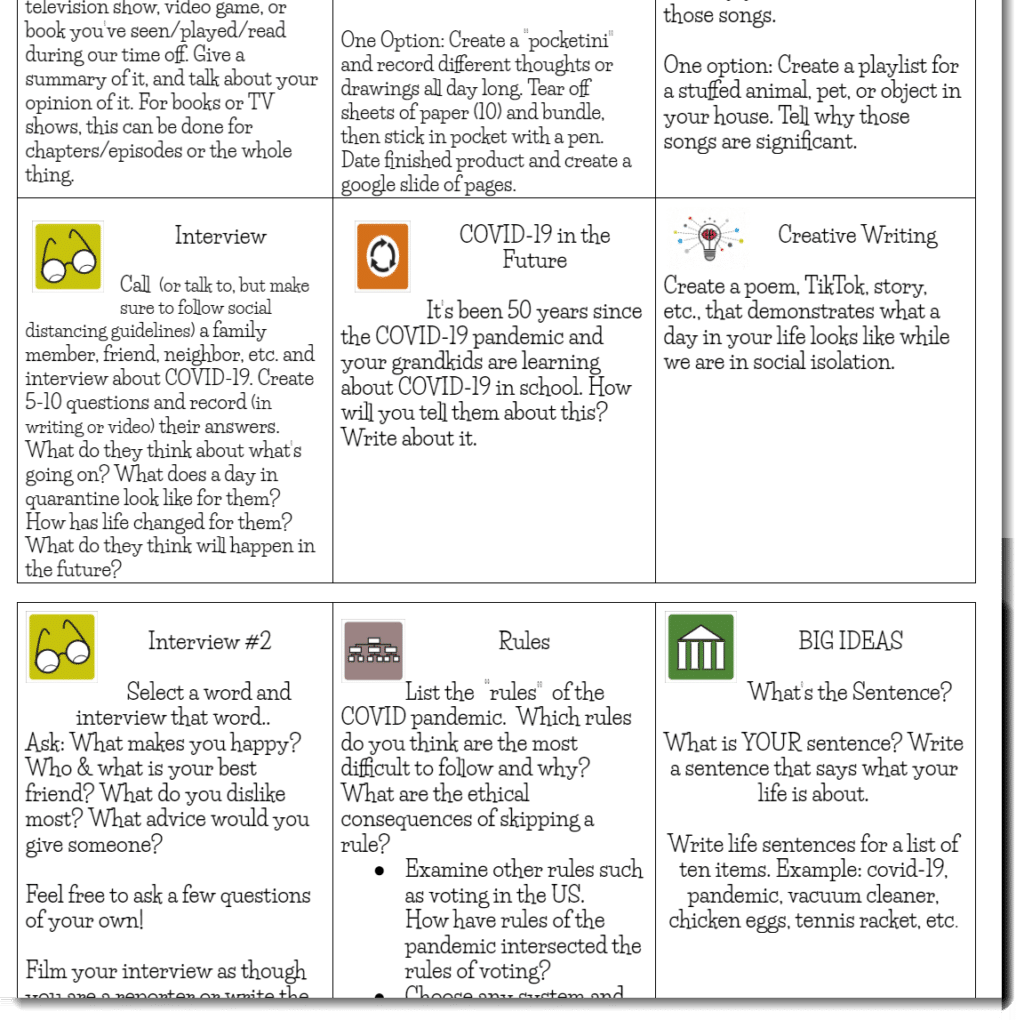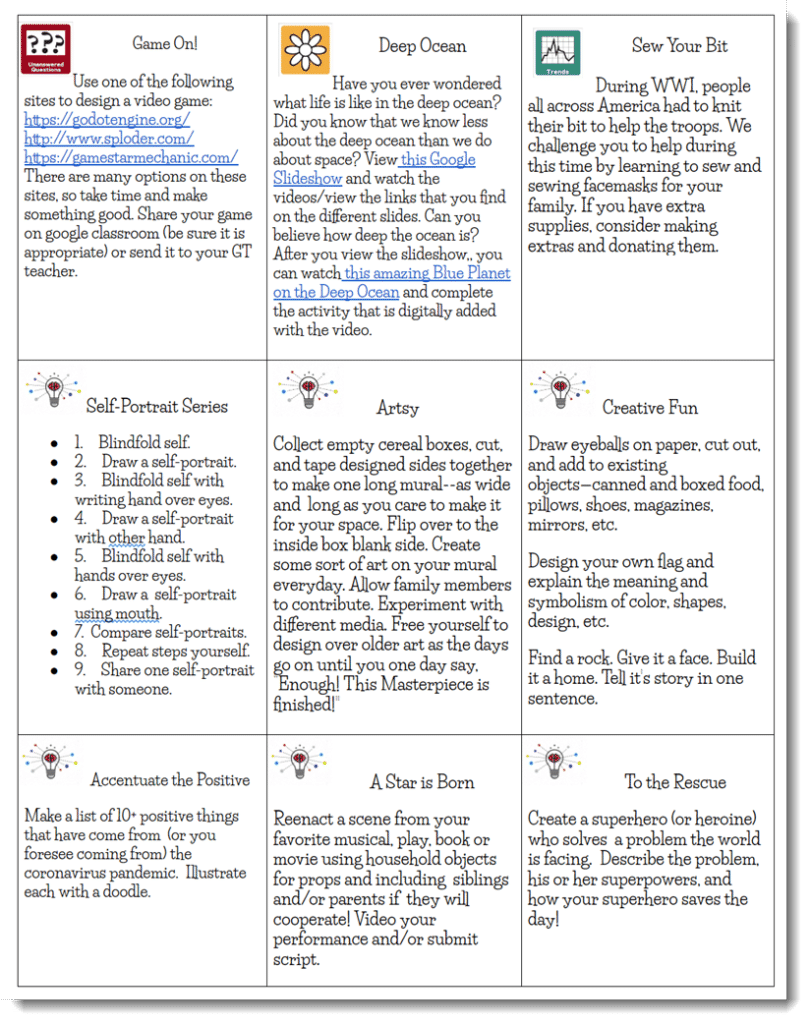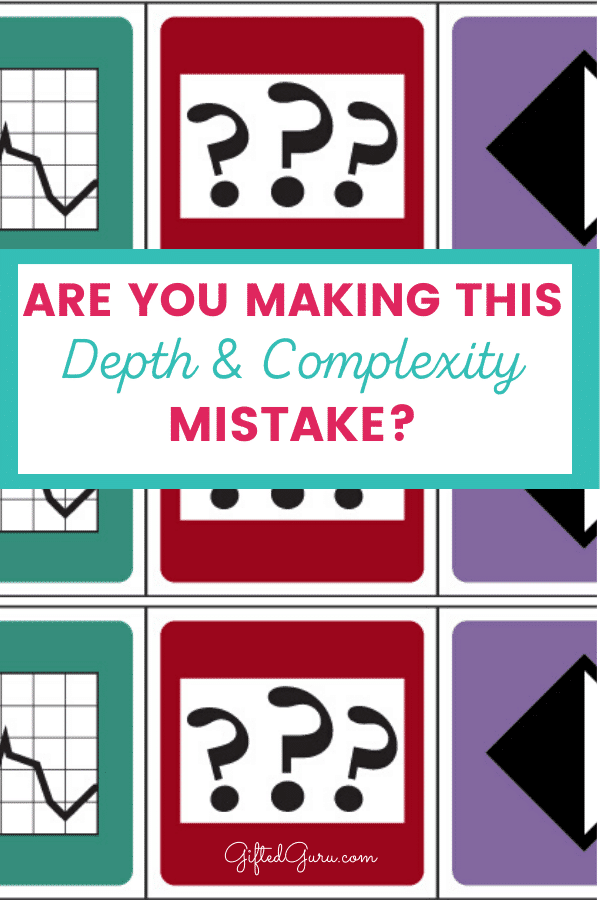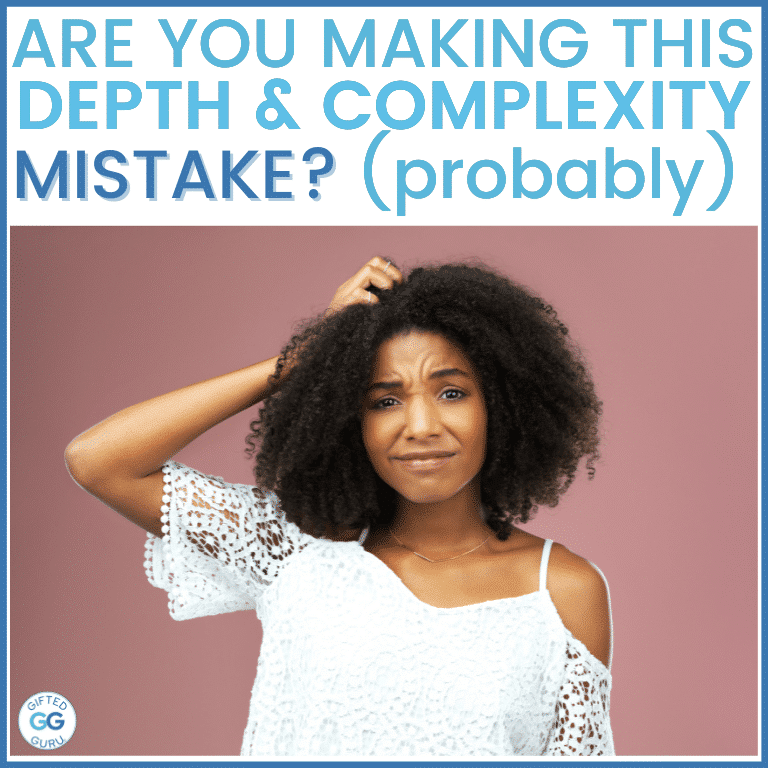Using the icons of Depth and Complexity without a strong task statement is a mistake. The task statement needs a strong through-line to the element, as well.
If you just have an icon and no task statement, or a task statement that has a tenuous connection to the element represented by the icon, that’s a mistake, too.
Let me show you what I mean and how to avoid this common Depth and Complexity mistake.
What do you do when you have something that there isn’t an icon for?
I received an email from a teacher who has been working with the Depth and Complexity framework. She had this question:
I have a question about creativity. Often, as GT teachers, we do exercises just to enhance and practice creativity. Is there an icon that’s specifically for creativity or creative thinking?
For example, my team has put together a choice board of … activities for this time while we’re out of regular school. We wanted to include depth and complexity icons (we’ve worked with them all year).
However, several of the activities are just practicing creativity. We started the discussion on a creativity icon. Maybe I’m just not seeing which D&C icon matches.
With her permission, I’m using her question and the choice board she mentions to highlight issue teachers face and how to handle it correctly.
It’s a common misperception, and I’m so grateful that she wrote and was willing to share so that we could help other teachers through example.
Why There’s no Depth and Complexity Element for Creativity
The quick answer to her question is that there is not a specific element for creativity because creativity should always be tied to some element of thinking.
There’s not really such a thing as “creativity” in isolation from other thinking. You need something to be creative about.
The same is true of critical thinking or any other very general term to describe a form of thinking.
Part of the strength of the Depth and Complexity framework lies in the fact that it forces teachers (and students) to drill down to the actual thinking and what the assignment is really calling for.
Looking at the Choice Board
For background, the choice board she refers to in the email is not a typical board with nine choices. Instead, it’s three pages long and has fifteen choices. (It’s designed to cover a longer period of time.)
It was created by several teachers working together. It clearly took a lot of work and has some really cool options on it. This took time to put together. Please do not take my focus on the Depth and Complexity issue as a dismissal of it.
Let’s dive in and see how we can use it as an example to help other teachers who face the same issue these teachers did, because I think it’s a common one.
Why You Need to Think about the Thinking More Deeply
Here’s an excerpt from the choice board:

This is just one section, but if you’re familiar with Depth and Complexity, you recognized right away that that light bulb picture does not belong.
(Cue Sesame Street song, “One of These Things is Not Like the Others.”)
The teachers are seeing this task as creativity in isolation, and so they chose this light bulb to represent creativity because there’s no icon for it.
However, as I said earlier, there’s no such thing as creativity in isolation. At least, there shouldn’t be. 😉
Here’s the task:
Create a poem, TikTok, story, etc., that demonstrates what a day in your life looks like while we are in social isolation.
Let’s look at what this task is asking.
What it’s really doing is asking students to compare how their daily life has changed from before the social isolation began. What element is that? It’s Change over Time.
If you asked students to analyze how they view their lives now versus how they viewed it before the virus, that would be Multiple Perspectives.
The reason they didn’t see the Depth and Complexity element is because the task statement is too weak. (I’d also argue strongly that it’s too vague.)
But how do you avoid that?
Choose the Direction You’re Going to Go
You have two choices:
- You can choose the thinking first (by selecting what element[s] of the framework you want students to focus on) and choosing activities to fit those thinking prompts, or
- You can choose the activities you want to use and then choose what kind of thinking you want students to approach the activity with.
In this issue, we’ve run into a problem because the activity was chosen, and then an icon was attached to it without really considering deeply enough what thinking we wanted students to engage in.
Personally, I prefer to choose the thinking first, but it’s fine to do either.
Are Choice Menus Themselves the Problem?
Ian Byrd parked a big ol’ bus on choice menus, and his most compelling argument is that it’s really hard to come up with a wide array of strong tasks (he has more issues with them, but this is a core argument).
I’m not 100% in agreement with him on this because I think that over time or with a hive mind of fellow educators it is possible to do it.
However, there is great difficulty in making quality opportunities in a choice board because of a lack of space (although there are work-arounds for that) and because of the pressure of coming up with lots of ideas. Lots.
No matter what the assignment is, it must always have a powerful task statement. Always.
Remember, you can choose the activity and then the thinking, but the activity is not the thinking. It’s merely a way to express the thinking.
I need to make tshirts that say that or rent a billboard in Times Square.
How Can You Tell If Your Task Statement Is Weak?
I use three clear tests to determine if a task statement is weak:
- Is the thinking skill obvious? Meaning, can the student easily tell what thinking (breadth and depth) is expected? Can a parent tell why I’d want a student to spend time doing this?
- Can I clearly explain what a good one would look like?
- Does it align with the standards I’m using or have set for myself?
Here, they started with the activity first (Create a poem, TikTok, story, etc., that demonstrates what a day in your life looks like while we are in social isolation), which is fine. Remember, that’s one of the two ways to do it.
However, where it goes wrong is that the thinking isn’t clear. Are students supposed to compare and contrast? (If so, that would be the Trends element).
Are they supposed to focus on their education? Their family life? Their social interactions? Are we looking for positive and/or negative? Are we supposed to come up with some Big Idea about it, or just give examples?
I mentioned before that the task statement here was too vague. You can probably see where I’m going, can’t you?
Can you tell from this what a good one would look like? No. All we have is poem, TikTok, story, etc.
I think you can guess how I feel about that etc., can’t you?
The issue isn’t that there isn’t a prompt for what they need. The issue is that they haven’t identified the actual thinking skill, and so they cannot tell yet what prompt is applicable.
What I Would Do Instead
Compare that task statement to these:
- Create a cinquain poem describing three ways in which your relationship with your friends is different now because of social isolation. [Change Over Time]
- Write a story with two characters and sixteen lines of dialogue that compares and contrasts how the characters’ lives have become more difficult because of social isolation. [Trends]
Do you see how much easier it is to identify the Depth and Complexity element when the task statement is strong and clear?
They will reveal themselves to you.
How to Identify the Correct Depth and Complexity Prompt
First, you have to know them. If you don’t know them well, you will struggle.
It’s fine to start with just a few, but really learn them.
Luckily, Ian and I wrote an entire book about Depth and Complexity, so I’d definitely recommend starting there.
Read carefully, not just for the specific strategies, but for the theory behind each element. Make sure you understand its purpose.
If you’re working with sophisticated thinking, you may need the Content Imperatives aspect of Depth and Complexity as well. If you are consistently struggling to identify the element you want, it may be time to add those to your toolbox.
Resist Using the Icons in Isolation
When I wrote this very nice teacher back explaining some of this, she responded with this important question:
So, your advice is to not use the icons at all in something like the choice board? I think we have the urge to do that because it helps us as teachers to think about the framework.
No, my advice is to identify the thinking you are asking for.
Do not use the icons in isolation. It’s not helpful.
They do not convey the strength of the framework. In our book, Ian and I say, “The elements are more than pictures: they’re thinking tools represented by icons.”
You’re not trying to create an icon for the task; you’re trying to identify which element is being utilized. If the answer is “none of them,” then you probably do not have a strong task.
Let’s look at a couple of other examples from the choice board that have that cute lightbulb and see if we can find the Depth and Complexity element.

- Self-portrait Series: In order to identify a Depth and Complexity prompt, you’d need to have some reason for doing this task. There’s no thinking being asked of students here. Why are they doing this? If you don’t address that, this is just drawing. It’s not difficult to do. Have them go watch a video about someone who had to learn to draw or paint with another part of their body and ask, “Normally, we draw with our hands. If you broke that pattern and had to draw with a part of your body other than your hands, would you choose your mouth or your feet?” [Patterns]
- Artsy: Same as above. Murals have purpose. What is this one’s? Without identifying it, you cannot identify the thinking.
- Creative Fun: You already know what I’m going to say, don’t you? Except I’m also going to add this: take out that apostrophe in “it’s”. Why are they doing this? Without a purpose, this is just busy work, not matter how cool it is.
- Accentuate the Positive: This one is already clear. This is Details. Just substitute the word “details” for “things” and you’ll see it clearly.
- A Star is Born: Why? I have the same feeling about this as about “Creative Fun” above. Without purpose it’s just a chore for the parents to feel exhausted about.
- To The Rescue: This is Ethics. Pros and cons, problems and solutions…all Ethics.
Wrapping Up
The icons are not there to look pretty or to make us feel good that we’re using them. They’re there to prompt different ways of thinking and to help us as educators make sure that we’re exposing students to different types of thinking.
If we find ourselves struggling to identify which element is applicable, we either don’t know them well enough (which can take time!) or we don’t have a strong enough task statement.
Hopefully this deep dive has been helpful to you.
Thank you so much to the teacher who asked the question. It takes a confident and committed educator to say, “Wait, this isn’t working like I think it should. Who can help me finesse this?” and then reach out.
If you have questions about Depth and Complexity, leave them in the comments below. You just may find a big, enormous article about your question!
**If you want to become a Depth and Complexity master, you can take the Depth and Complexity Course. Learn more here.
You May Also Like:
- A Depth and Complexity Differentiated Lesson Plan Step-by-Step
- Depth and Complexity Rules Cards
- Why I Love Depth and Complexity
- Our Book!





